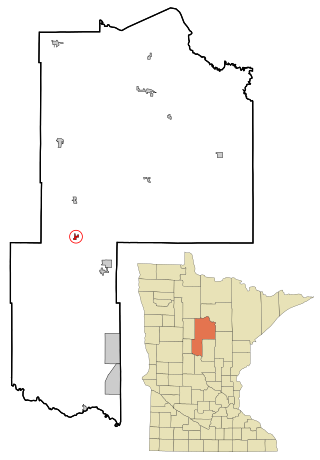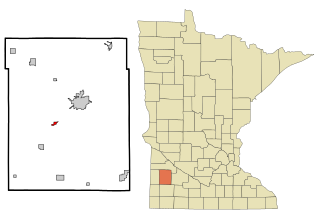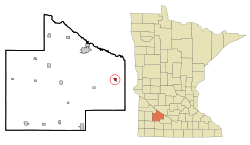
Ramsey is a suburban city 22 miles (35 km) north-northwest of downtown Minneapolis in Anoka County, Minnesota, United States. The population was 27,646 at the 2020 census. It is a northwest suburb of the Twin Cities.

Barry is a city in northern Big Stone County, Minnesota, United States. The population was 16 at the 2020 census.

Backus is a city in Cass County, Minnesota, United States. The population was 250 at the 2010 census. It is part of the Brainerd Micropolitan Statistical Area.

Chickamaw Beach is a city in Cass County, Minnesota, United States. The population was 114 at the 2010 census. It is part of the Brainerd Micropolitan Statistical Area.

Lake Shore is a city in Cass County, Minnesota, United States. The population was 1,056 at the 2020 census. It is part of the Brainerd Micropolitan Statistical Area.

Lynd is a city in Lyon County, Minnesota, United States. The population was 448 at the 2010 census. Lynd is a small but growing community in southwestern Minnesota. The development of a new golf course and an additional housing development have started a growth trend that may eventually double the size of the community. It is primarily a bedroom community for individuals who work in the nearby city of Marshall. Despite being much smaller in size, it historically played a more significant role in the area. The Kiel and Morgan Hotel in the town was the original Lyon County seat.

Elmdale is a city in Morrison County, Minnesota, United States. The population was 114 at the 2020 census.

Harding is a city in Morrison County, Minnesota, United States, along the Platte River. The population was 123 at the 2020 census.

Bluffton is a city in Otter Tail County, Minnesota, United States, along the Leaf River. The population was 210 at the 2020 census.

Deer Creek is a city in Otter Tail County, Minnesota, United States. The population was 330 at the 2020 census.

Dent is a city in Otter Tail County, Minnesota, United States. The population was 173 at the 2020 census.

Erhard is a city in Otter Tail County, Minnesota, United States. The population was 132 at the 2020 census.

Henning is a city in Otter Tail County, Minnesota, United States. The population was 854 at the 2020 census.

Ottertail is a city in Otter Tail County, Minnesota, United States. The population was 629 at the 2020 census.

Urbank is a city in Otter Tail County, Minnesota, United States. The population was 52 at the 2020 census.

Maplewood is a city in Ramsey County, Minnesota, United States. The population was 42,088 at the 2020 census. Maplewood is ten minutes' drive from downtown Saint Paul. It stretches along the northern and eastern borders of Saint Paul.

Morgan Township is one of the twenty-six townships of Redwood County, Minnesota, United States. The population was 305 at the 2000 census.

Dakota is a city in Winona County, Minnesota, United States. The population was 295 at the 2020 census.

Federal Dam is a city in Cass County, Minnesota, United States, near Leech Lake. The population was 110 at the 2010 census. It is part of the Brainerd Micropolitan Statistical Area.

Minnesota Lake is a city in Blue Earth and Faribault counties in the State of Minnesota. The population was 661 at the 2020 census. The bulk of the city is in Faribault County; a small part extends into Blue Earth County.






















